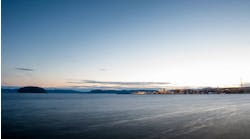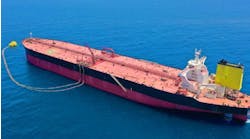Digitized platforms enable zero-defect construction of offshore facilities
Laser scanning technology increases accuracy
null
John M. Rothermel, James McGill - Quantapoint
With oil prices at $60 per barrel or higher, many offshore platforms are being modified to keep production levels as high as possible. Unfortunately, many platforms have little or no as-built (or existing condition) documentation. Additionally, much of what does exist is out-of-date or of questionable integrity.
Bad or non-existent as-built documentation increases the risk for misalignment of piping and other equipment, obstructions in areas targeted for modification, and increased rework and hot work. This results in schedule, cost, production capacity, and safety.
Traditionally, companies have attempted to update as-built documentation using the following steps: (1) team members visited the site and gathered notes after making manual spot measurements with tape measures and plumb bobs; (2) once back at the office, the notes were converted into drawings; (3) which were then handed to the design engineers who created new facility structure around the existing structure; (4) fabricators built components from the design drawings; and finally, (5) an erector attempted to assemble the parts into the existing facility.
Digitizing a platform
Laser scanning is a relatively new technology that replaces manual surveying tools. It is the tool that can be used to digitize a platform - from the waterline to the helideck. The digitized platform includes dimensional and layout information and can be accessed on desktops anywhere in the world to support owners and operators, engineering consulting firms, or project management teams for revamps, asset management, maintenance, safety, training, or facilities and equipment upgrades.
What are the steps involved in digitizing an offshore platform? First, the goals and desired end results of the project are identified to ensure full understanding of requirements. Second, a two-person field crew uses laser scanning to capture overlapping 3D scans for individual areas of the platform, a process that can take from two to 10 days, depending on the size of the platform. Third, advanced algorithms integrate (or register) the laser scans into a network with a measurement uncertainty of no worse than 3 mm from any point to any other point. Fourth, photo-realistic 3D laser models are created that provide a cohesive, high fidelity 3D database for the platform. Finally, the dimensionally accurate and physically complete digitized platform - consisting of the registered laser scans and 3D laser models - is delivered to the client.
Once a platform has been digitized, there is little or no need to send personnel back to the platform. The digitized platform may be accessed directly and can be used to create 2D drawings (equipment layouts, sections, piping & instrumentation diagrams, piping isometrics), extract exact locations for tie points for piping or structural modifications, review proposed designs against actual existing conditions, and to perform constructability reviews such as construction sequencing.
The digitized platform may also be accessed using standard 3D CAD software, such as Aveva PDMS, which is one of the most commonly used packages. By enabling designers to use existing conditions for their designs, clashes, interferences, or construction issues can be identified and corrected during the design phase at much less cost than during construction.
Finally, maintenance and operations teams can also use the digitized platform as an intuitive visual entry point for information such as operations best practices, safety procedures, replacements parts and other information that may be available, but is typically scattered across a network.
Companies that have used digitized platforms have realized a number of benefits. For example, a major integrated oil company used the digitized platform to reduce engineering design time by 60 days by resolving interferences during early design. As a result, there were zero clashes and no rework, which eliminated multiple days of construction barge charges and advanced the start-up of the rehabilitated platform by months. Typically, companies achieve the following results:
- reduced project cost and risk: 90% less hot work, 90% less rework;
- optimized schedules: 80% less data collection time, 30% reduction in revamp schedule;
- increased quality: 100% clash-free designs from 3D CAD integration, accurate integrity critical 2D drawings; and
- improved safety and security: 50% fewer people in field, 75% fewer trips to hazardous areas and regions.
Barriers
The major barrier to more companies digitizing all of their offshore platforms is reluctance to try a new approach. Project teams typically adhere to the traditional manual surveying and measuring techniques because that’s how they’ve always done it, and they are unsure of the best way to use this technology.
To help address these concerns, project teams should first understand their project goals and desired end results, be it schedule, cost, or rework. Project teams may contact a provider company to help identify work processes and best practices that will help them achieve their goals. Here are some tips for initiating a mutually beneficial relationship with a qualified provider:
- Ask for case studies demonstrating offshore experience;
- Ask for three or more customer references for offshore projects;
- Do homework on the provider. Visit the company’s Web site. Ask for white papers, articles, presentations, and other publications that demonstrate both understanding and expertise;
- Ask the candidate provider to review the work process it uses to ensure you receive maximum value from your investment;
- Evaluate how well the company has been able to help its clients achieve their goals, including schedule, budget, technical, quality, and safety.
John M. Rothermel is Quantapoint’s VP of international business development. James McGill is the company’s VP of marketing.





